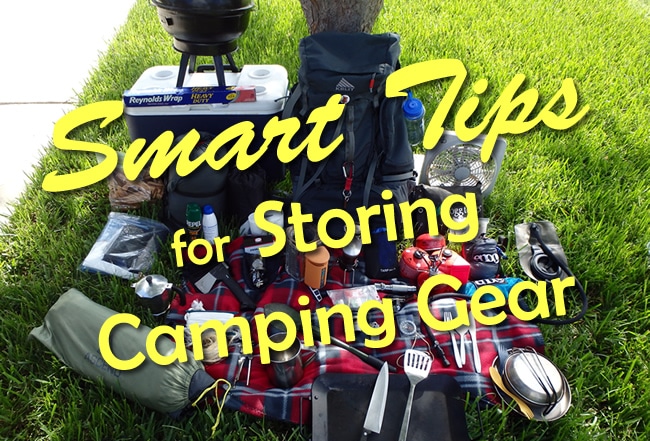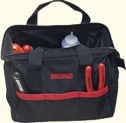
Imagine your first camping trip of 2015. You’ve already booked your favorite site at American River Resort. Winter is finally gone, and the kids are all excited to go camping. A few days ahead, you start pulling out the camping gear to check it and make inventory.
But wait! What’s that smell? And is that mold growing on the air mattress? Why is there a leg missing from the camp stove? No way is that a hole chewed by mice in the sleeping bag!
Family camping is too much fun to be bogged down by hassles from not storing gear properly. So here’s a list of smart tips for putting your equipment to bed for winter.
TIP #1: Two Words, Clean and Dry
This is our #1 tip because it makes the biggest difference. Seems obvious right? Clean the mud, dirt, sand, etc. off everything and let it have enough to time to dry and air out before you pack it away. Sleeping bags, tents, tarps, raingear need special attention. Before storing, hang or drape them over a fence or something outside in the sun for a while. When storing, a few dryer sheets thrown in with tent and sleeping bags keeps things smelling fresh. As for cooking equipment, run it all through the dishwasher before storing.
TIP #2: Think Storage that Transports
Store camp equipment inside containers that not only protect from moisture, critters and bugs, but that conveniently transport everything to and from camp. This means plastic with tight lids or heavy impenetrable canvas or nylon bags with good zippers and handles. The idea is that your camping equipment spends the winter inside the very containers you’re going to grab, come Spring, and throw into your vehicle. To make this work to your best advantage, follow tip #3.

We’ve read good reports about large plastic bins with good handles and latch-on lids. See-through is good, but if yours aren’t, label them with permenant marker on strips of duct tape. If you like heavy duty storage containers that transport well in truck beds, we recommend these made by Husky and found at home improvement stores.
TIP #3: Small Containers Inside Large Containers, Labelled
When it comes to camp equipment, especially items smaller than tent and camping stove, etc., organization is your best friend. Plastic zipper bags, small to large, make this easy. Don’t skimp. Buy good heavy-duty bags.
Zip like items together in a bag sized to fit, and nest smaller bags of items into a larger bag. For example, bag playing cards together inside a larger bag with other games. Bag mosquito repellent, cintronella candles and anti-itch cream together. With a marker write “for mosquitos” on the bag. This could go inside a larger bag or container with first-aid type items, also bagged and labeled. Now, you not only have what you need in one place but you also have a place holder for returning those items to. A-hah. Now you’re getting the picture!
 One expert source recommends canvass tool bags for camp items, such as those made by Craftsman. They come in many sizes and configurations. We can’t think of a better way to keep camp kitchen utensils or first aid, or even toiletries organized and transportable.
One expert source recommends canvass tool bags for camp items, such as those made by Craftsman. They come in many sizes and configurations. We can’t think of a better way to keep camp kitchen utensils or first aid, or even toiletries organized and transportable.
Eventually, all bags or small bins go into larger containers that store and transport as per tip #2.
Stick to this system for items that don’t get stored, but are gathered a day or two in advance of camping. (Using those empty labelled bags from last year also serves as a checklist of what to take.) Once at camp, you’ll never have to rummage through boxes or bags of loose items at camp looking for that bottle opener you know “is somewhere in one of these boxes.” This may all seem to be making the storage of camp gear more complicated. But once your system is in place, it actually serves to simplify the process. Try it and you’ll see.
TIP #4: Dedicated Storage Space
Where’s the best place in your house to store camping stuff? The answer is anywhere you decide, but it’s best to have it all in one dedicated place rather than scattered throughout closets, cupboards and drawers in your house. The most likely spot can be in the garage, out of the way on a high shelf. That’s probably okay, especially if it’s inside containers (tip #3) that prevent pests and moisture from getting to it. But keep in mind that, while garage temperature swings will not hurt most equipment, anything combustible such as matches, propane tanks, or such things as candles and aerosol cans should not be stored in high heat susceptible places. As for sleeping bags, some campers prefer storing them indoors, hanging in a closet or under a bed (unrolled and lying flat actually helps preserve the “fluffiness” of the stuffing.)
Wherever you find space, if you’ve followed tips 1-3, your equipment with be safe from moisture and critters, which are the biggest threats. Or are they?
TIP #5: Take Your Camping Gear Camping
Actually the biggest threat to camping equipment is not using it. Take it camping for goodness sake! You’ll know its condition, what needs replacing, what items are practical and most useful, what has faired well in storage, and what can be stored better next time.
If you take good care of it, store it smartly, and take it camping often, your gear will fulfill its whole purpose for being. Camping means fun times with loved ones, lasting memories, and keeping traditions alive. Your equipment becomes your tools to support and make these possible.
Invest in good equipment and good methods of maintenance and storage. Keep it simple, keep it practical, keep it fun!
